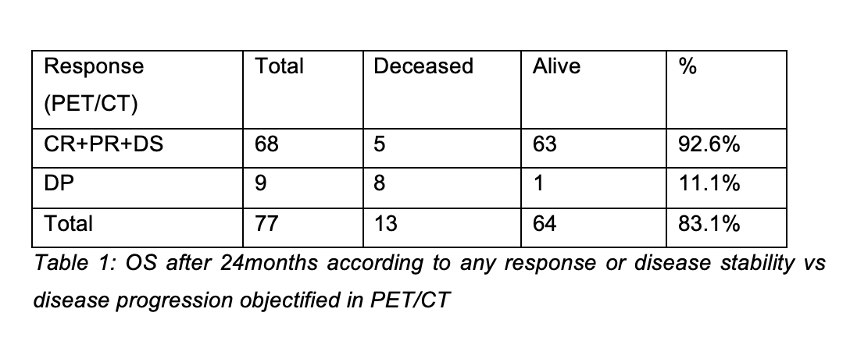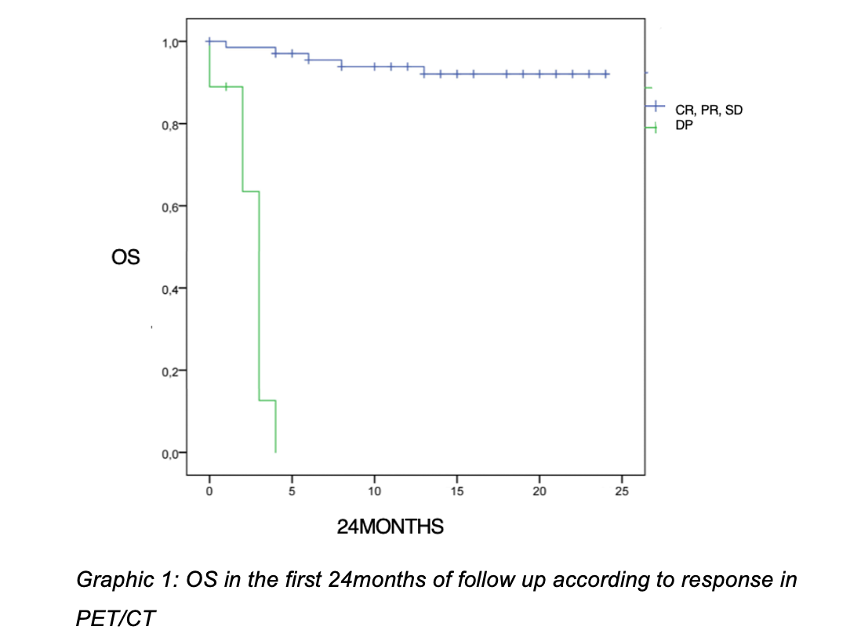EARLY RESPONSE IN 18FDG-PET/CT AS PROGNOSTIC FACTOR IN LOCALLY ADVANCED CERVICAL CANCER
MARIA ISABEL GARRIDO BOTELLA,
Spain
PO-1345
Abstract
EARLY RESPONSE IN 18FDG-PET/CT AS PROGNOSTIC FACTOR IN LOCALLY ADVANCED CERVICAL CANCER
Authors: MARIA ISABEL GARRIDO BOTELLA1, MARTA RODRIGUEZ ROLDAN1, MACARENA TEJA UBACH1, MERCEDES GONZALEZ CANTERO1, ISABEL RODRIGUEZ RODRIGUEZ1, ELISABET GONZALEZ DEL PORTILLO1, BELEN BELINCHÓN OLMEDA1, ROSA MORERA1
1HOSPITAL UNIVERSITARIO LA PAZ, RADIATION ONCOLOGY, MADRID, Spain
Show Affiliations
Hide Affiliations
Purpose or Objective
Standard treatment in locally advanced cervical cancer (LACC; FIGO stage ≥IB2) is definitive concurrent chemoradiotherapy (cCRT), with external beam radiotherapy and weekly cisplatin, followed by brachytherapy (BT). 18F-fluorodeoxyglucose positron emission tomography – computed tomography (18FDG-PET/CT) is a useful tool to assess response after treatment.
Some studies have analyzed specific overall survival (OS) according to physiologic response using 18FDG-PET/CT. In the early assessment of tumoral response, the regression of the tumor after treatment could be a survival predictor.
By this study we want to describe survival rates in the first 24 month of follow up according to early response using 18FDG-PET/CT.
Material and Methods
A retrospective observational study was performed, including patients (n=77) with LACC treated with cCRT (treatment volume defined according to RTOG guidelines, with 3D conformed radiotherapy or volumetric modulated arc therapy with 6-MV photons, to a total dose of 45-50.4Gy, 1.8Gy per fraction 5 days a week, with dose escalation if positive pelvic nodes or extracapsular extension on paraaortic lymphadenectomy were objectified, and 2-7 cycles of weekly cisplatin) followed by high dose rate BT (total dose of 26Gy, 6.5Gy per fraction, twice a week, with Iridium-192, using Ring or Fletcher applicator) between 2010-2018 in our institution.
Response to treatment was objectified 18FDG-PET/CT in all patients performed 3 months after treatment. Results were classified as complete response (CR), partial response (PR), stable disease (SD), or disease progression (DP). We described survival rates in patients with complete or partial response or stable disease compared to survival rates in patients with disease progression.
Results
OS after 24 months of follow up in patients with PR and CR to treatment or SD objectified in early 18FDG-PET/CT was 92.6% and in patients with DP was 11.1% (p<0.001).
Better survival rates were objectified according to better response with 93.9% of patients with CR, 88.9% of patients with PR, and 11.1% of patients with DP alive after 24 months of follow up.
Response to treatment or SD after treatment affects OS, reducing decease risk 98.6% (p<0.001 by Cox Regression).


Conclusion
Patients with early response or disease stability had better survival rates during follow up compared to patients with disease progression. Early response objectified in 18FDG-PET/CT performed 3 months after treatment is a good prognostic factor to estimate cause-specific survival rates in these patients.
Further investigation should be done to stablish early 18FDG-PET/CT as a definitive prognostic tool to estimate survival rates in these patients.